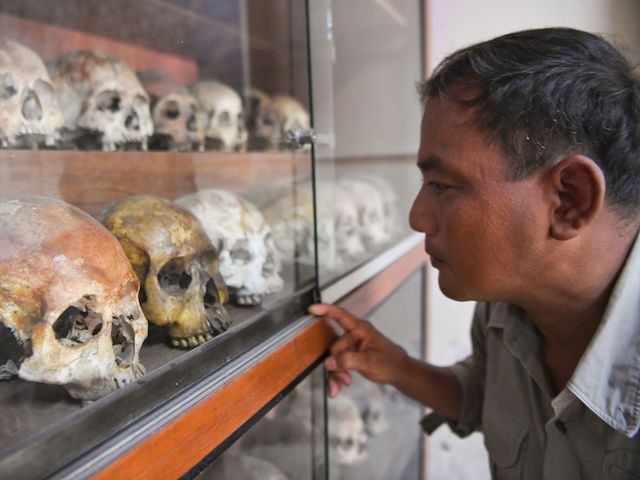Vice Media on Sunday removed an article featuring digitally altered photos of Cambodian genocide victims with smiles on their faces after complaints from the Cambodian government and a petition to demand an apology from the media organization.
The article, originally posted on Friday, showcased the work of Irish digital artist Matt Loughrey, who said he wanted to humanize victims of the genocidal Khmer Rouge, a Communist insurgency supported by China that tortured and killed up to 2 million people in the late 1970s.
Loughrey took black-and-white photos of prisoners from the infamous S-21 torture and execution camp, a facility that once served as a high school called Tuol Sleng”, and used software to both colorize them and alter some of their expressions. He added a few other embellishments to some of the photos, such as a bloody handprint on the wall behind one prisoner.
Tuol Sleng became one of the most horrifying atrocities ever perpetrated. Tens of thousands of Cambodians were taken there by the Khmer Rouge, but only seven are known to have survived.
Loughrey told Vice he colorized the photos to emphasize the everyday humanity of the S-21 victims, turning them into smiling neighbors-next-door instead of grim-faced captives resigned to their terrible fates. The magazine interviewer specifically asked about those images in which the subject appeared smiling, to which Loughrey did not directly state that he had added the smiles, appearing to imply that some of those photographed indeed smiled in their last moments.
“Out of 100 images I looked at, the data showed that the women tended to have a smile on their face more so than the men. I think a lot of that has to do with nervousness,” Loughrey said, never stating in the comments as published that the smiles were fabricated. “We smile when we’re nervous. We smile when we have something to hide. One of the classic things is to try to be friendly with your captor. So a smile would seem natural.”
As the Killing Fields Museum of Cambodia notes, the Khmer Rouge were fiendishly obsessed with photographing their captives, recording the details of their torture, and transcribing their interrogations. Some of their photographic records include horrifying little details:
At first glance, the photograph of a shirtless young man appears typical of the prison photos. Closer inspection reveals that the number tag on his chest has been safety pinned to his pectoral muscle. With a bruised face and a pad-locked chain around his neck, a boy stands with his arms at his sides and looks straight into the camera. A mother with her baby in her arms stares into the camera with a look of indignant resignation.
Whatever the artist’s intentions, his work drew immediate condemnation from the Cambodian government and people.
“This was done without the consent of family members who lost loved ones in the prison, and with other Cambodian community organizations who are involved in this work,” said the National Cambodian Heritage and Killing Fields Museum in an official statement. “Minimizing the pain and trauma of our community from those who are not connected to the experience is not only revising and erasing history, it’s a violent act. There is no celebration from these traumas.”
The Cambodian Ministry of Culture and Fine Arts said the photos “are in violation of the dignity of Cambodian Genocide victims and of the rights of the Tuol Sleng Genocide Museum” and threatened to take legal action under Cambodia’s Archives Act of 2005. The Tuol Sleng Genocide Museum also described the altered photos as an affront to the dignity of the victims.
Although Loughrey said his work had drawn a “huge response” from audiences, the backlash on social media after his Vice profile was fierce, with critics calling his work “tasteless,” “racist,” “insulting,” and “tone-deaf,” and accusing him of “falsifying history.”
“No words can ever fully describe the dreadful feelings hidden behind those faces who knew they would soon be marched to the mass graves. But here they were transformed into celebratory, smiley portraits for an artful show off. Inconsiderate and offensive!” one angry Cambodian said on Twitter.
At least one relative of an S-21 victim claimed Loughrey gave false information about her slain uncle to Vice and lied about talking to his son, since his son did not survive the genocide. Thousands of signatures were added to a petition demanding Loughrey delete the altered photos and apologize.
Author Marina Amaral, noted for creating highly realistic colorized versions of photos from the Holocaust, said a line was crossed by altering the Cambodian photos beyond simply adding color:
“This whole thing makes me sad. It affects artists who have been working hard for years to make people understand that we are not playing around with crayons. There’s usually a huge sense of responsibility involved,” Amaral said.
Under intense criticism for posting the altered photos, Vice first added an editor’s note to the article about Loughrey, then deleted it entirely on Sunday. The original article did not mention that the images had been altered.
A statement from the media company said:
The article included photographs of Khmer Rouge victims that Loughrey manipulated beyond colorization. The story did not meet the editorial standards of Vice and has been removed. We regret the error and will investigate how this failure of the editorial process occurred.
Loughrey has generally avoided commenting on the controversy, although he reportedly responded to one Cambodian critic by dismissing her complaints as “nonsense,” insisting he is not “falsifying history,” claiming most of the response to his project has been “positive,” and musing that his public “calling out” on social media as “odd” because his detractors could have contacted him personally to discuss his work.

COMMENTS
Please let us know if you're having issues with commenting.